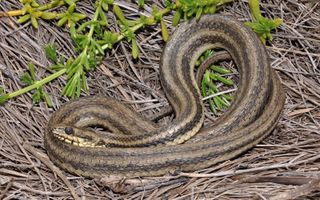Atlantic salt marsh snake: Difference between revisions
m (→Documents) |
mNo edit summary |
||
| Line 11: | Line 11: | ||
<p>The specific name, <i>clarkii</i>, is in honor of American surveyor and naturalist John Henry Clark (1830-1885).</p> | <p>The specific name, <i>clarkii</i>, is in honor of American surveyor and naturalist John Henry Clark (1830-1885).</p> | ||
<h2><span id="Description">Description</span></h2><p>Salt | <h2><span id="Description">Description</span></h2> | ||
<p>The Atlantic Salt Marsh Snake is a slender, heavily keeled water snake with a pattern of stripes that are variously broken into blotches. The dorsal ground color is pale olive, patterned with a pair of dark brown stripes running down the back and enclosing a pale mid-dorsal stripe. These dark stripes usually become fragmented posteriorly into a series of elongated blotches. There is also a row of dark blotches along the lower side of the body, which may merge to form stripes in the neck region.</p> | |||
<p>The <b>Atlantic salt marsh snake</b> (<i>N. c. taeniata</i>), is restricted to a small stretch of coastline in Volusia and Indian River Counties, Florida. This race has a color pattern of four dark stripes on the neck which are replaced by a series of dark blotches or bands on the posterior portion of the snake's body. It is currently listed as a Threatened Species by the US Fish and Wildlife Service.</p> | |||
<h2><span id="Taxonomy">Taxonomy</span></h2> | <h2><span id="Taxonomy">Taxonomy</span></h2> | ||
<h2><span id="References">References</span></h2> | <h2><span id="References">References</span></h2> | ||
| Line 26: | Line 29: | ||
==Documents== | ==Documents== | ||
* [https://www.fnai.org/PDFs/FieldGuides/Nerodia_clarkii_taeniata.pdf FNAI - Atlantic salt marsh snake (''Nerodia clarkii taeniata'') (PDF 2pp)] | * [https://www.fnai.org/PDFs/FieldGuides/Nerodia_clarkii_taeniata.pdf FNAI - Atlantic salt marsh snake (''Nerodia clarkii taeniata'') (PDF 2pp)] | ||
* [https://ecos.fws.gov/docs/tess/species_nonpublish/2908.pdf ECOS - Atlantic salt marsh snake - Nerodia clarkii taeniata - 2019 Review (PDF 19pp)] | * [https://ecos.fws.gov/docs/tess/species_nonpublish/2908.pdf ECOS - Atlantic salt marsh snake - Nerodia clarkii taeniata - 2019 Review (PDF 19pp)]. Retrieved May23, 2022. | ||
* [https://www.govinfo.gov/content/pkg/FR-1977-11-29/pdf/FR-1977-11-29.pdf#page=35 Federal Register 1977 USFWS Determination for Atlantic Salt Marsh Snakes (PDF 168pp 43MB)]. Retrieved May 23, 2022. | |||
==Web Links== | ==Web Links== | ||
Revision as of 14:45, May 23, 2022
Nerodia clarkii taeniata, commonly known as the Atlantic salt marsh snake, is a species of semiaquatic, nonvenomous, colubrid snake found only in the Atlantic coast salt marshes of Volusia and Brevard County, Florida.
Etymology
The specific name, clarkii, is in honor of American surveyor and naturalist John Henry Clark (1830-1885).
Description
The Atlantic Salt Marsh Snake is a slender, heavily keeled water snake with a pattern of stripes that are variously broken into blotches. The dorsal ground color is pale olive, patterned with a pair of dark brown stripes running down the back and enclosing a pale mid-dorsal stripe. These dark stripes usually become fragmented posteriorly into a series of elongated blotches. There is also a row of dark blotches along the lower side of the body, which may merge to form stripes in the neck region.
The Atlantic salt marsh snake (N. c. taeniata), is restricted to a small stretch of coastline in Volusia and Indian River Counties, Florida. This race has a color pattern of four dark stripes on the neck which are replaced by a series of dark blotches or bands on the posterior portion of the snake's body. It is currently listed as a Threatened Species by the US Fish and Wildlife Service.
Taxonomy
References
External links
- Herps of Texas: Nerodia clarkii
- Texas Parks & Wildlife: Gulf Salt Marsh Snake
Further reading
- Baird SF, Girard CF (1853). Catalogue of North American Reptiles in the Museum of the Smithsonian Institution. Part I.—Serpents. Washington, District of Columbia: Smithsonian Institution. xvi + 172 pp. (Regina clarkii, new species, p. 48).
- Boulenger GA (1893). Catalogue of the Snakes in the British Museum (Natural History). Volume I., Containing the Families ... Colubridæ Aglyphæ, part. London: Trustees of the British Museum (Natural History). (Taylor and Francis, printers). xiii + 448 pp. + Plates I-XXVIII. (Tropidonotus clarkii, p. 238).
- Conant, Roger; Bridges, William (1939). What Snake Is That?: A Field Guide to the Snakes of the United States East of the Rocky Mountains. (With 108 drawings by Edmond Malnate). New York and London: D. Appleton-Century Company. Frontispiece map + viii + 163 pp. + Plates A-c, 1-32. (Natrix sipedon clarkii, pp. 105–106 + Plate 20, Figure 57).
- Cope ED (1895). "On some new North American Snakes". American Naturalist 29: 676-680. (Natrix compressicauda tæniata, new subspecies, pp. 676–677).
- Kennicott R (1860). "Descriptions of New Species of North American Serpents in the Museum of the Smithsonian Institution, Washington". Proceedings of the Academy of Natural Sciences of Philadelphia 12: 328-338. (Nerodia compressicauda, new species, pp. 335–336).
- Powell R, Conant R, Collins JT (2016). Peterson Field Guide to Reptiles and Amphibians of Eastern and Central North America, Fourth Edition. Boston and New York: Houghton Mifflin Harcourt. xiv + 494 pp., 47 Plates, 207 Figures. <link rel="mw-deduplicated-inline-style" href="mw-data:TemplateStyles:r1067248974">ISBN 978-0-544-12997-9. (Nerodia clarkii, pp. 414–415 + Plate 40).

